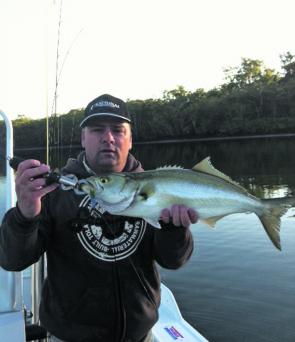Moreton Bay in September is famous for glorious conditions and fish in good form; keep an eye out for those large high pressure systems that are the key to a good run of many species.
All of the Bay islands fish well through early spring, with snapper, bream, tailor and sweetlip showing up pretty much the same places as in late winter. Water clarity is great; so try the shallow water around the islands using natural patterns in all artificials for a safe bet. Strip baits are still popular in these locations and unweighted baits; cast out and left completely alone until a strike occurs will dramatically reduce your snag rate.
Flathead, on the inside of Moreton Island, should fire up this month. They are an exception to the natural colour rule as pink is still the favourite with many anglers using plastics, hardbodies and fly.
For those who want to go further out, reefs around the Cape have been productive with snapper up to 80cm still showing up. The 5-7” plastics are accounting for a lot of these fish in a variety of colours on any given day.
As spring kicks in so do our thoughts of warmer waters and different species on offer. However, as the official seasonal calendar does not control fishing seasons in the same defined time frame, September is a month that usually produces all winter species in good numbers.
Mulloway, snapper, bream, luderick and tailor continue to be caught all through September. After spawning, their energy levels drop and feeding becomes a priority for those fish trying to regain body fat and condition. Hot sessions on all the above mentioned species are on the cards.
Flathead are always a year round target, but September and October are well known for large specimens in all our coastal waterways. Keep your approach in spring the same as late winter, until a noticeable change in temperature is in place.
All South East Queensland foreshores and estuaries continue to fish well, so get out there and good luck.
On a recent trip we found the going a bit tough in the river, despite the good conditions. Two mulloway, some bream and pike were all we could muster between four anglers for a lot of casts.
Days like this are not uncommon, as I’m sure most readers will agree, but they can have a positive effect on future trips. When your regular spots don’t fire look around for new ground to try rather than pull the pin and head home early.
Two species to consider for September are mulloway and whiting. Mulloway catches can hit their peak in early spring, with large fish on offer. Yellowtail pike are always a great live bait for these fish.
A great spot to catch pike is the southern foreshore rock wall just around the corner from the mouth. You should have no problem spinning up what you need at any stage of the tide. The flats on the northern side of the river mouth are a great spot for large whiting. This is one of those locations that seems to fire on both sides of the tide, with live blood worms the pick for most anglers in this area.
Remember to keep an eye on shipping when fishing these areas.
In this month’s issue I thought we might have a look at flyfishing in the dams. All natives can be taken on fly, and whether you’re a novice or expert angler, you can draw great satisfaction from this form of fishing. Dams are good locations, particularly for novice anglers, with large clear areas for back casts common.
Once a basic cast is learnt, turn your attention to working the fly. Insect patterns are best fished in short sharp strips as this is normal action for most insects on or just under the surface. However, if shrimp or fish patterns are your choice then a more continuous steady strip is the norm.
Floating and sinking lines behave in very different manners when airborne and I suggest that first timers start with a weight forward full floating line, as this gives you a good visual on how stripping techniques make flies behave. Also, full floating lines with a sinking fly are an effective way to fish shallow edges of dams.
With starting kits available from under $150, it’s a very affordable option to try.
• At the Tackle shop we are continually expanding our range. We now have a lot of new products in store at very competitive prices. We have something for everyone, from beginner to expert. Also, we still have the largest ranges of fresh and frozen baits in Brisbane. Our business hours are from 5.30am-6pm Monday to Friday, Saturday from 4am-6pm and Sunday 4am-4pm. If would like more information on tips and techniques, locations or for an up to date fishing report please give us a call on 38629015 or just call in 1754 Gympie rd Carseldine ( The Caltex service centre on the way out of town ). Myself and my team are all mad keen fishos and are always happy to help.
Fly suggestions for September
Wooley buggers
Vampires
Streamers
All shrimp patterns
Dahlbergs
Reads: 1580
After spawning, mulloway’s energy levels drop and feeding becomes a priority for those fish trying to regain condition, which is good news for anglers!

Steve Andrews from the Tackle Shop with a tailor from the Pine River.




